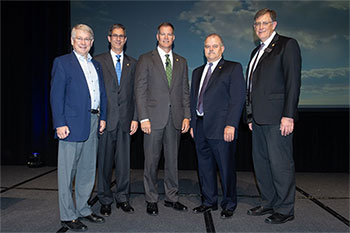Life in the F-35 ‘Fish Bowl’ Written 26 June 2018
Panelists: Moderator Juan J. Alonso, professor, Stanford University; Jeff Babione, vice president and general manager, Advanced Development Programs, Lockheed Martin
by Ben Iannotta, Aerospace America editor-in-chief

Lockheed Martin’s Jeff Babione challenged the audience of the “Evolution of the F-35” session June 26 at the 2018 AIAA AVIATION Forum in Atlanta to utter the first words that came to mind when they thought of the F-35.
After some minor prodding, a voice in the crowd said “cost overrun.” Another said “schedule.” And a third voice, which was difficult to hear, seemed to say “not as good as the F-16.”
Issuing this challenge was Babione’s way of encouraging people to reconsider their perceptions of the F-35 program as Lockheed Martin seeks to reboot opinions about the multibillion joint and international initiative that has indeed been marked by schedule delays and cost overruns. Since the program’s last re-baselining, Babione said, the company has been rolling out the F-35 aircraft nearly as planned in terms of cost and schedule.
“It was tough, but we got there,” he said.
Babione knows the F-35 program as well as anyone. Before moving earlier this year to head Lockheed Martin’s Advanced Development Programs, or Skunk Works, he was the general manager in charge of the F-35 for more than two years. For almost three years before that, he was the deputy in charge of day-to-day program management. His speech and a Q&A session moderated by Juan J. Alonso of Stanford University opened a series of “special programming” sessions at the forum planned for June 26 and June 27 to discuss the F-35 program and its history.
Babione ticked off a list of milestones for the audience. Among them, he noted that the system development and demonstration phase, involving numerous test flights, was completed earlier this year, not long after the planned 2017 date under the re-baselining. He said the program is running “just several percentage points higher on cost.” He said initial operational test and evaluation flights are scheduled to begin in August under the program’s strategy of conducting tests concurrently with low-rate initial production.
Pointing to a cost chart, Babione said that today, an A model of the F-35 — the version that will eventually replace the U.S. Air Force’s F-16s and A-10s — costs $94 million. He said the company envisions the cost declining to $80 million per plane by 2020.
Babione said Lockheed Martin has been open about the hurdles it has faced over the years and that there are no shortage of challenges ahead. He displayed a slide showing a goldfish in a bowl surrounded by the corporate logos of CNN, Facebook, Fox News, YouTube and Twitter.
“Do I look at all like that goldfish? Because that’s how it feels to be on the F-35 program,” he said, joking about searching G-O-D on Google and realizing that the F-35 received more hits.
None of that was meant to be a complaint, Babione suggested: Oversight of a multibillion program is certainly “reasonable,” he said, adding that transparency is the “hallmark” of the program.
“You can’t claim we’re hiding anything,” he said.
